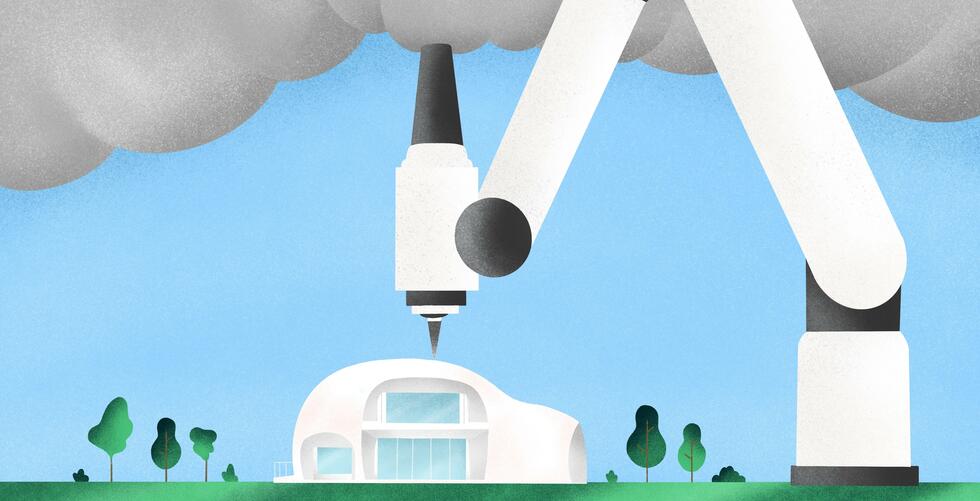The Tree Counter
Thomas Crowther believes that data is key to combating climate change. The British ecologist found out that there are many more trees on earth than scientists previously believed. But still, 3 trillion are not enough. The potential for reforestation is enormous, says the renowned expert. At the Crowther Lab in Zurich, he is developing nature-based solutions to restore the global ecosystem.

They used to call him “the tree counter”. Eight years ago, just after obtaining his doctorate at Cardiff University, Thomas Crowther started counting. And he just kept on and on. At that time, nobody really knew exactly how many trees are growing on Earth. There were only rough estimates based on satellite imagery – but this did not satisfy the young ecologist.
Thomas Crowther relentlessly gathered data from ground observations. Some of his colleagues mocked him for this seemingly futile venture, as they believed that most scientists would not share their hard-earned data. But Thomas Crowther convinced more and more researchers to do so, and in 2015, his astonishing findings were published in the renowned “Nature” journal.
Tom, you found out that there are 3.04 trillion trees on Earth. Previous estimates suggested that there are only 400 billion. Why this big discrepancy?
Previous tree estimates were based exclusively on satellite images, but these do not show what is going on below the canopy. This is why we combined satellite imagery with actual boots on the ground surveying one-square-meter plots of forest and physically counting the trees in each plot. This enabled us to compare our findings with the previous estimates that were based on satellite images and thus calculate a more accurate number.

Ecologists and activists claim that reforestation is the most efficient strategy to fight climate change. Can planting trees really save the planet?
Planting trees alone will certainly not be enough to combat climate change. Cutting emissions is just as important. However, restoring forests and other ecosystems is certainly one of the simplest methods to achieve tangible results in drawing down carbon.
How many additional trees could potentially be planted on earth?
Our study showed that there are 0.9 million hectares of land that could naturally support forests. We have not published a precise number, but we estimate that there is a reforestation potential of roughly one trillion trees. The greatest potential lies in areas that used to be forested but that are now degraded due to human activity. Most of this land that is neither built on nor used for agriculture can be found in the tropical regions.
Your research base is Zurich. How many degrees warmer will this city be in 2050?
It is difficult to give an accurate prognosis, but our study on the urban heat island effect suggests that Zurich’s climate in 2050 could be similar to that of Milan today. This would mean many hot days way beyond 30°C in summer and average winter temperatures far above 0°C. As last winter showed, snow in the city could become the exception.
Four years after Thomas Crowther published his pioneering findings in “Nature”, the journal published a lengthy feature about the 33-year-old. The article portrays him as a rock star among ecologists, funded by a multimillion-euro grant, interviewed by the BBC and Al Jazeera, and envied by some of his less famous colleagues who publicly doubt the value of his research.
Today, Thomas Crowther is a tenure-track professor of Global Ecosystem Ecology at the Swiss Federal Institute of Technology (ETH) in Zurich where he founded the Crowther Lab. The 30 scientists, including ecophysiologists, mathematicians, and programmers, focus on measuring ecosystems using geospatial maps. This interdisciplinary team maps trees, fungi, and microbes in order to develop methods to restore our planet

In a blog, you wrote that the answer to climate change lies in data. How much do we know about the global ecosystems today?
There are still many gaps to fill. The more we learn, the more we realize what we don’t know.
What potential for climate research do you see in technologies such as artificial intelligence and machine learning?
AI and machine learning constitute an enormous opportunity for scientists. They allow us to play through millions of scenarios in a matter of seconds, which would have taken years and years before. These technologies are accelerating our rate of learning and eliminating the need for trial and error.
Climate researchers focus mainly on the surface of the earth, but you are also interested in soil-dwelling microorganisms. Why?
Soil is the largest carbon sink on earth; it currently stores 1500 gigatonnes of carbon dioxide in the top two meters alone. Previous research suggests that this layer has the potential to store an additional 116 gigatonnes. Not to mention that soil organisms greatly impact the plants that can grow on the surface. Healthy soil is a basic prerequisite for trees to grow at all. So, the soil and the microorganisms living in it play a crucial role when it comes to achieving the carbon drawdown.


About Thomas Crowther
Thomas Crowther (33) is professor of Global Ecosystem Ecology at ETH Zürich where he formed the Crowther Lab in 2017. His scientific work aims to generate a holistic understanding of the global scale ecological systems which regulate the Earth's climate
Written by:
Illustration: Xavier Mula









































































































